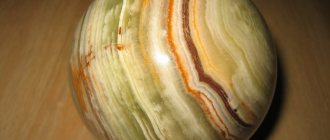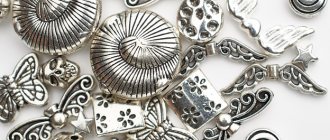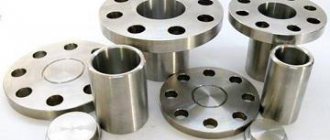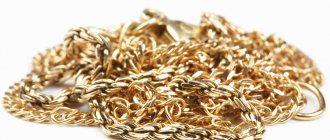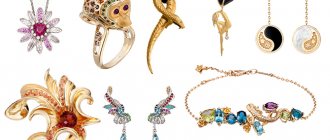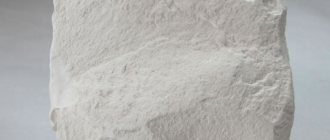Jewelry alloy is a combination of several inexpensive metals (compared to noble ones), which is used to make jewelry. To create an alloy, metals with different properties and characteristics are used. This allows you to obtain high-quality compounds that are resistant to external irritants.
Jewelry alloy decoration
Description of the alloy
Gold jewelry alloys are quite popular , but many people do not know what they are and what elements they contain . Their main component is gold (75–98%). The following additional components can be used: silver, copper, palladium, platinum. By adding additional metals, you can make an alloy with any shade - from red to light yellow, greenish.
Jewelry alloys are used to make expensive jewelry:
- rings;
- necklace;
- earring;
- tiara;
- tie clips;
- cufflinks
Ferrous metals, iron-carbon alloys with additions of chromium and nickel, are not considered jewelry, but they are used to make cheap products that imitate white gold and platinum. Stainless and surgical steel began to be used for the manufacture of various accessories with the advent of Art Nouveau, grunge, and punk styles. The alloy does not darken from moisture and does not cause allergies.
How to choose jewelry by alloy
The use of various alloys in jewelry is very wide, so it is often difficult to understand all the tags and samples. If you want to get a really expensive and high-quality product, pay attention to the following nuances:
- The optimal gold content in the alloy is 58.5%, as indicated by gold standard 585. Such products do not turn black and do not lose their shine. In addition to the sample, in a rectangular recess there should be a stamp next to it with the image of the profile of a woman in a kokoshnik. This marking is required for domestic jewelry.
- The most valuable silver alloy is 925 standard, where silver is 92.5%. Such products do not bend or melt. They can turn black with constant contact with water. Therefore, it is better to store silver rings and earrings separately in a box, removing them during water procedures and sleep.
- Platinum alloy is not as popular, but if you find it in a jewelry store, look at the shape of the recess under the sample. It should be a polygon with numbers in the center. The optimal samples for jewelry are 900 and 950.
Important! In addition to the sample and mark on the product itself, a tag must be attached to the jewelry. It contains a lot of information about the manufacturer and supplier. And also, starting from 2022, a special barcode will be applied that will tell the entire “history” of the product.
Tips for allergy sufferers
A little secret from jewelers. If you are allergic to gold, it is most likely caused by the presence of nickel in your jewelry. To avoid ruining your mood by not being able to wear jewelry, pay attention to platinum alloys. They are as beautiful and expensive as gold. Among them there are jewelry with diamonds, sapphires and other gems.
If finances allow, you can buy palladium products. They are distinguished by their strength and durability. And they are also decorated with precious stones. And if palladium and platinum are beyond your means, you can choose openwork silver items. There are a lot of them in all jewelry stores in the country.
History of discovery
There is no exact information about when the first jewelry alloys appeared, but it is believed that even before our era, monarchs, rulers, and military leaders decorated their homes with various metal products, which were inlaid with precious and semiprecious stones.
The concept of “jewelry alloy” appeared in the 19th–20th centuries, when similar materials were separated into a separate group. From that moment on, jewelry began to actively spread throughout the world.
Golden Lion (Photo: pixabay.com)
Appearance
The popularity of jewelry alloys is explained by their attractive appearance and low price. They are used in the manufacture of jewelry, coating large products that are used as decoration.
Any experienced jeweler can determine by the type of jewelry what metals they are made of and what predominates in the combination. Example:
- A dull matte shade indicates tin content. The products weigh little, but due to their fragility they can become unusable under any mechanical influence.
- Green, yellow and gray shades indicate brass content. Such decorations are quite rare.
- A reddish tint indicates the presence of copper. With active wear, the color of the product may change.
- A silver or metallic tint indicates the presence of steel.
A dark shade indicates nickel content. This is a rather harmful additive because it causes allergic reactions in people with sensitive skin. The rarest jewelry alloys contain titanium.
Medical and other stainless steels
Familiar from an early age with the shine of spoons, forks and other cutlery, “stainless steel” is the absolute leader among jewelry alloys used in the manufacture of modern accessories. Let's start with it.
Already by the spoon, which has served unbendingly for decades, one can judge the quality and service life of steel accessories for ladies’ jewelry. The spoon looks like new, despite repeated immersions in aggressive chemical environments. And it’s okay if it’s just soup, her shiny one doesn’t even care about the effervescent reactions of soda and vinegar. Even if you hit the table with all your might, it will survive, unless it leaves a scratch or a dent, but it won’t hurt the tabletop either. And how elegant stainless steel spoons can be, here you will find curls, embossing, and gilding. And all this at a reasonable price: it is incomparable with the price of the same silverware.
Stainless steel is in demand in costume jewelry for the same reasons. The resilient material is relatively inexpensive and, importantly, harmless to health, even in cases of close and prolonged contact with bare skin. By the way, it is safety that many manufacturers and sellers of steel fittings claim as one of the most important advantages. They even write “medical steel” on the product cards or product passport. And this is where logical questions arise. If the earring wire is indeed made of the same alloy that is used on surgical instruments, can it be threaded into a newly pierced earlobe? Won't a small wound require a lot of treatment after this? Will the wire itself deteriorate, oxidizing and darkening? Yes, yes, this happens sometimes. Stainless steel, the same one that is harmless and outwardly unchanged, turns out to be capable of breaking its own rules. However, it only inevitably becomes a consequence of breaking the rules, for the sake of improving aesthetics or reducing production costs.
Stainless steel is an alloy of steel (iron and carbon) and chromium. The chromium content usually does not exceed 11-18%. This is enough for the so-called “alloying” - adding impurities and additives that improve the quality of the base material.
The fact is that iron is highly susceptible to oxidation. Under the influence of oxygen contained in water or air, it is destroyed and becomes corroded. Chromium, which is present in stainless steel, also reacts with oxygen and is also covered with a layer of oxides. And the trick is that the film of chromium oxide is invisible to the eye, but by covering the steel surface impenetrably, it prevents contact of iron with oxidizing agents, thereby protecting it from corrosion.
There are many grades of stainless steel used in various sectors of the economy and industry. All of them, due to different impurities and their percentages, differ in the characteristics of weight, strength, malleability, etc.
The same alloys that are used for medical purposes are suitable for jewelry needs: stainless steel marked AISI 304, its improved version AISI 316, etc. However, “medical alloy” and “jewelry alloy” are not always synonymous concepts. Manufacturers often experiment with their own recipes for stainless alloys for fittings, adding, for example, nickel, titanium, molybdenum and other alloying components, which give the finished products additional strength, flexibility, and decorativeness.
For example, nickel serves as an excellent hardener and at the same time enhances shine. Products made from this alloy have an expensive shine. But about a fifth of the world's population suffers from allergic reactions to nickel. A severe case from the ring or earrings is unlikely, but an itchy rash is very likely.
Therefore, it is still not worth relying on the fact that all stainless steel of jewelry alloys is equally “medical”.
It is not uncommon for steel jewelry fittings to have non-standard colors. The silveriness of stainless steel sometimes has a tint, or even a pronounced color. The reason for this may be both coloring impurities in the alloy composition and PVD coating (Physical Vapour Deposition). The first case may contain surprises uncharacteristic of stainless steel, such as a change in color over time from attractive to nondescript. The second is a fairly expensive jewelry technology, which, in addition to a beautiful color, gives the steel additional protection from external influences and significantly increases the price of the finished product.
Summarizing the above, we add that stainless steel fittings are truly irreplaceable. She is appreciated for:
- Strength;
- Wear resistance;
- Resistance to deformation (a ring made of high-quality stainless steel cannot be stretched or compressed, and even the thin backing of a crystal or brooch will not bend at the slightest effort);
- Consistency of color and shine
- Affordable price.
Branded fittings produced by famous brands meet all expectations, although their cost is somewhat higher. But the one that is cheaper, without great fame and a proven reputation, reserves an allowance for the characteristics of semi-handicraft stainless steel. It may turn out to be too fragile, or suddenly darken. If you come across an unfamiliar manufacturer, and the seller cannot provide certificates, then it makes sense to test an element of dubious fittings purchased as a sample, and only then make further plans for it.
Compound
Since alloys based on silver, gold and platinum are expensive, people often choose costume jewelry. More often, tin is used as a base, which is combined with other metals - antimony, copper, aluminum, etc.
Prohibited additives
In addition to nickel, which can cause allergic reactions on the skin, lead was previously actively added to jewelry alloys. This metal remains on the skin, which causes discomfort and redness. Lead has now been added to the list of prohibited additives for jewelry making.
Lead (Photo: pixabay.com)
Types of coatings
Various materials are used to coat jewelry alloys. Types of coatings:
- Gold plating. Increases the strength and resistance of the product to mechanical stress and the influence of environmental factors. In order for the jewelry to retain its properties longer, the layer of gilding must be large enough.
- Jewelry alloy with rhodium plating or palladium film. These metals give the product a silvery tint. Spraying cannot be called very durable or wear-resistant, but it does not darken even with prolonged use.
- Ruthenium coating. The film changes the appearance of the jewelry to silver. The product acquires a characteristic metallic tint.
- Silver plated. The main disadvantage is rapid darkening in the absence of appropriate care.
- Copper coating. It is most often used to process bracelets, rings, and pendants to make them look like antique gold or bronze.
Kinds
Types of jewelry alloys:
- Cupronickel. A compound of manganese, iron, copper and nickel. Outwardly, it can be confused with silver. Does not darken over time, has high strength, does not corrode, and is easy to clean.
- Alpaca. Consists of tin, zinc, nickel, copper. This alloy first appeared in Mexico. It acts as a substitute for silver, but compared to it, alpaca has a duller shade.
- Neusilberg. Properties and characteristics are similar to alpaca and cupronickel-based alloys. Consists of zinc, nickel, copper. Has high elasticity and strength. The product takes on a green or blue tint.
- Red brass. An alloy of copper and zinc. Externally it resembles gold. It has high resistance to rust formation and ductility. Products made from this material are often covered with gold and enamel.
- Brass. An alloy with high wear resistance and strength. The main component is copper, to which nickel, manganese, tin, and zinc are added. Externally, brass looks like gold. Does not cause allergies.
You can also add bronze to jewelry alloys, which is characterized by high strength and wear resistance.
Brass faucet (Photo: pixabay.com)
Features of silver for jewelry
Do you think what silver jewelry alloy is made of? It most often includes silver, aluminum and nickel . Moreover, auxiliary components are needed not only to increase the strength index, but also to reduce metal oxidation. Pure ore quickly turns black due to interaction with oxygen.
Interesting fact. Silver jewelry alloy was invented more than 6,000 years ago. Already in Ancient India, silver jewelry was very popular. And in Rus', women specially wore silver rings on their hands, since it was believed that this metal kills germs during milking of cows.
Modern silver “solution” has high plasticity and melts at a temperature of +960.5 ⁰С. The metal is characterized by high thermal and electrical conductivity.
Advantages and disadvantages
Pros:
- Low price compared to jewelry made from precious metals.
- Hypoallergenic. The products are suitable for people with sensitive skin.
- Big choice. You can find different types of jewelry in stores.
Minuses:
- Susceptibility to environmental factors. If you do not properly care for products made from such materials, they will quickly lose their original appearance.
- Not durable compared to jewelry made from precious metals.
- No indication of the exact composition of the alloy.
How to use and care
Cupronickel, like fine silver, fades and darkens over time. Even with proper storage, zero humidity in the room is unattainable.
Cleaning
The easiest way to add shine is to buy a special cleaner for cupronickel. Its disadvantage is the need to thoroughly rinse the item after cleaning. Especially dishes.
Generations of owners have tested methods of caring for nickel silver using improvised means:
- Apply a mixture of moistened soda to flannel, suede or other soft fabric. Rub the surface until results are obtained.
- Pour ammonia over the products, then rinse with running water and wipe dry. You can work wearing a mask.
- Boil cupronickel in a decoction of garlic, onion peels or crushed eggshells.
Cleaning with tooth powder, toothpaste, crushed chalk, or products containing bleach is excluded. The first three will scratch the product. The latter will make the cupronickel darken.
Usage
After washing cupronickel dishes after a meal, rinse them with a soda solution (45-50 g per liter of water).
Dishes or other items are immediately wiped dry to prevent them from becoming dull.
Regular thorough cleaning of jewelry or devices will not hurt even if they are used constantly. Resuscitating “neglected” cupronickel will take more time, effort and nerves.
It is better to store products (dishes and jewelry) closed in their “original” packaging. Alternatively, wrapped in cling film or foil. This will minimize mechanical or “wet” effects. That is, they will not be scratched or darken.
Features of care
Jewelry alloys have low resistance to environmental factors. If left untreated, they will quickly lose their attractiveness. Therefore, you need to study the rules for caring for such jewelry in advance.
Does the alloy darken?
To understand whether a jewelry alloy darkens or not, you need to study its composition and coating. Products coated with silver will darken even if proper care is followed.
Is jewelry alloy susceptible to corrosion?
Without an additional protective coating, some alloys may rust if exposed to moisture for a long time. If the metal on which the jewelry is made has high corrosion resistance, the risk that the surfaces will become covered with rust is minimal.
Cleaning methods
To clean jewelry, you can use napkins or soft cloths. The use of cleaning products and soap is not recommended.
Where is it used?
The properties of cupronickel ensured its use by industrialists, decorators, and bankers.
Industry, medicine
The structure of the alloy allows all types of mechanical processing - cutting, forging, stamping, soldering. And at any temperature.
This determines the areas of application of cupronickel:
- High precision resistors, heat generators.
- Production of components for trawlers, cruise ships, ocean liners. And private yachts of the premium segment.
- In combination with lithium, nickel-iron alloys are purchased for the production of batteries. They are three times more effective than their analogues. Lithium, as the lightest metal, reduces the massiveness of the filling of nickel-zinc or ferrous batteries.
Cupronickel is a material for medical instruments: scalpels, forceps, etc.
Plus the possibility of decorative processing of products (chasing, cladding, polishing).
Decor
Decorators work with alloy in two directions:
- Jewelry. Rings, earrings, necklaces, and cufflinks made of cupronickel are indistinguishable from silver in appearance. However, large companies are not interested in the alloy due to its low cost. It is more often done by hand-made masters. The processing makes them look like museum pieces.
- Dishes. Sets of cupronickel tableware - spoons / forks / knives / sockets / tureens - are a pride and heirloom in many homes. Their advantages: they are several times cheaper than silver ones, but more durable and look presentable.
Especially good are gold-plated, silver-plated, blackened or other coated surfaces.
Applying such a layer is not only a tribute to aesthetics or status. Pure cupronickel imparts tangible metallic notes to food. Copper is toxic, especially when hot.
Banking sector
Wear resistance, coupled with low cost, prompted the National Banks of many countries to issue cupronickel coins.
Almost all silver-colored coins in circulation are made of cupronickel.
In the USSR and Russia, coinage is controlled by GOZNAK:
- In the 1930-1950s, nickels, 10-, 15-, 20-kopeck coins were issued.
Today, the subject of numismatists' hunt is a Soviet patch of the 1937 model.
- Since the 70s, the line has been supplemented with anniversary and regular “rubles”.
The last Soviet coin was the bimetallic 10-rublevik.
In Russia, until the mid-1990s, coins were minted in denominations of 10, 20, 50, 100 rubles. After the redenomination of 1997 - 1 and 2 rubles.
